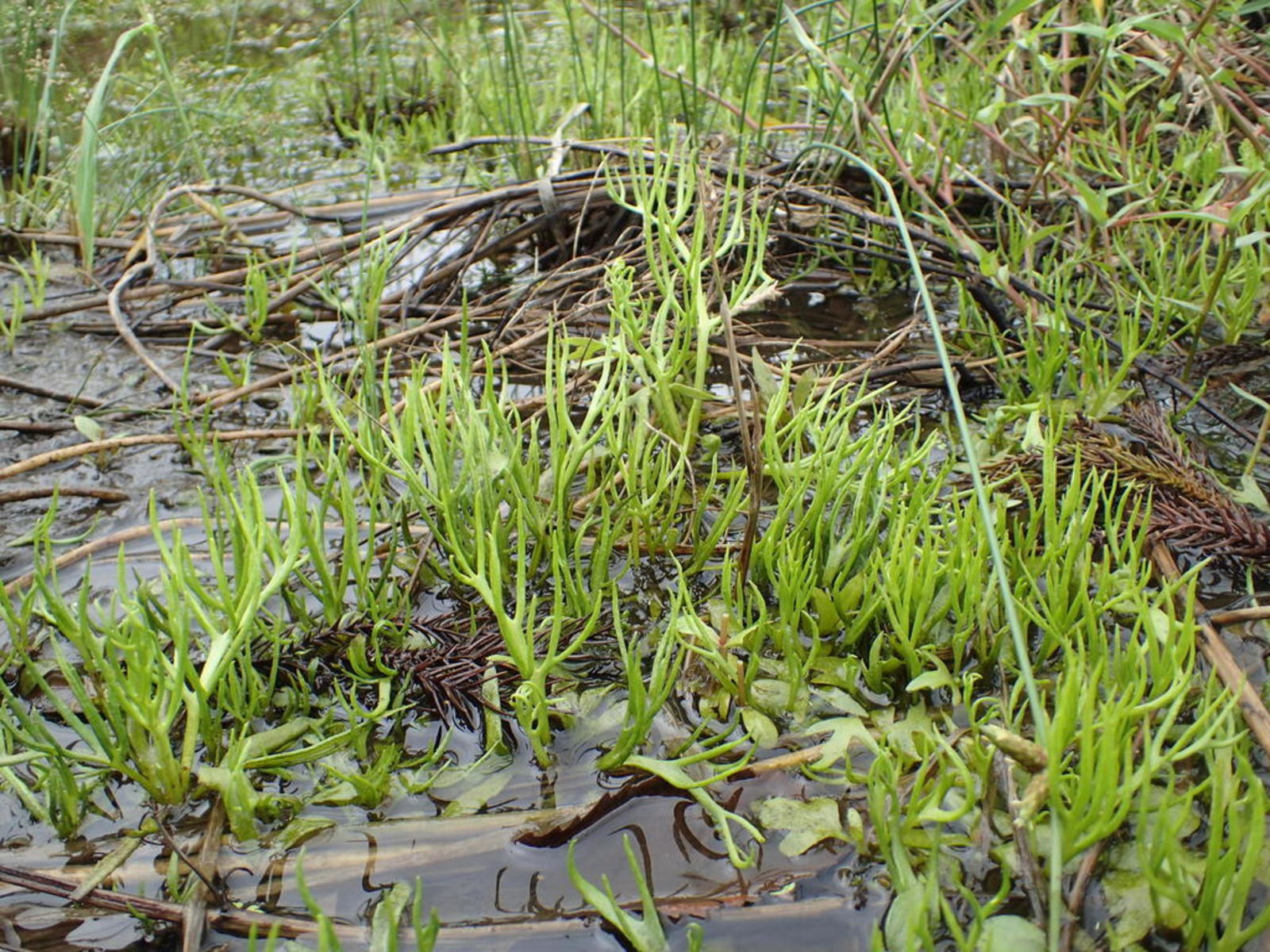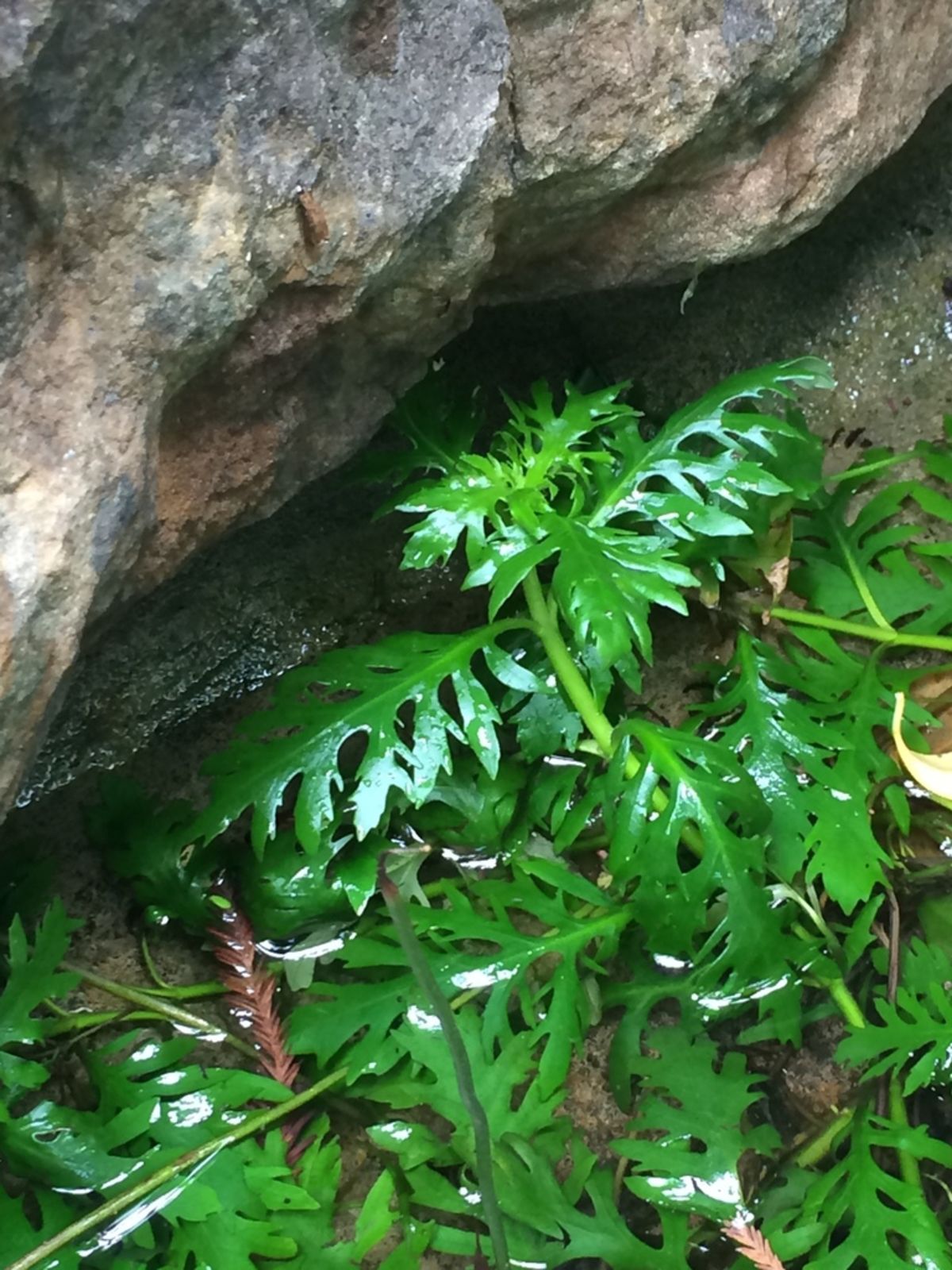Water Fern, Water Horn Fern
ceratopteris thalictroides
Also known as: ["Water Fern","Water Horn Fern","Indian Fern"]
Overview
A fast-growing aquatic or semi-aquatic fern with delicate, pinnate leaves, often used in aquariums and water gardens.
Benefits & Perks
["fast growing","shade tolerant","wildlife attractant (bees, butterflies, birds)"]
Botanical Classification
| Phylum: | Tracheophyta |
| Class: | Polypodiopsida |
| Order: | Pteridales |
| Family: | Pteridaceae |
| Genus: | Ceratopteris |
| Botanical Name: | Ceratopteris thalictroides |
Plant Characteristics
Basic Information
- Category: Leaf Plants
- Suitable Location: aquatic or semi-aquatic environments, such as ponds, aquariums, or bog gardens
- Suitable For:
- Is Weed: No
- Allergenicity: low
Environmental Needs
- Climate: {"temperatureRange":"18–30°C"}
- Hardiness: {"zones":"9–11"}
- Misting: rarely required, as it thrives in high humidity environments
- Drainage: Fast-draining to prevent waterlogging; ensure excess water can escape freely.
- Soil Type: Well-draining, rich in organic matter; a mix of peat, perlite, and loam works well.
Maintenance Level
- Maintenance Level: moderate
- Toughness Level: moderate
- Pruning Frequency: As needed, typically every few weeks during active growth; minimal pruning required for healthy plants.
- Pruning Intensity: Light to moderate; focus on removing damaged or old fronds without drastically reducing foliage.
Care Details
Ideal Sunlight Coverage:
Bright indirect light for 6–8 hours daily; tolerates lower light but may grow more slowly; avoid direct sunlight which can scorch leaves.
Sunlight Tolerance Tips:
Acclimate the plant gradually to brighter light if moving from low-light conditions; place in a spot with filtered light or dappled shade outdoors; indoors, use sheer curtains to diffuse direct sunlight.
Care Requirements
Care Difficulty
easyeasy
Sunlight
partial shade to full shade
Rotate the plant weekly for even growth; use grow lights if natural light is insufficient; monitor for leaf burn in high light.
Watering
every 3–5 days, allowing soil to dry slightly between waterings
Water thoroughly until it drains from the bottom, allow the top inch of soil to dry slightly between waterings, and avoid letting the plant sit in standing water.
Soil
moist, nutrient-rich, loamy soil with good organic content
pH: Slightly acidic to neutral (pH 5.5–7.0).
Use a mix that holds moisture but doesn’t stay soggy; ensure pots have drainage holes; top-dress with compost annually.
Temperature
Prefers temperatures between 65–85°F (18–29°C); thrives in warm, humid conditions; sensitive to cold drafts and sudden temperature drops.
Avoid placing near air conditioning vents or heaters; maintain stable temperatures; monitor humidity levels in hot weather.
Fertilizing
every 4–6 weeks during active growth with a balanced liquid fertilizer
Always water before fertilizing to prevent root burn; flush the soil occasionally to prevent salt buildup; choose a fertilizer with micronutrients for optimal growth.
Propagation
Methods
Stem cuttings or by separating rhizomes; stem cuttings root easily in water or moist soil.
Step-by-Step Propagation Guide
- Select a healthy stem, cut below a node, remove lower leaves, place in water or moist medium, change water weekly or keep soil moist, wait for roots to develop.
Best Time: Spring or early summer when the plant is actively growing; avoid propagation during dormancy.
Environment
Warm, humid conditions with indirect light; maintain consistent moisture without waterlogging.
Medium
Clean water or a well-draining potting mix with perlite or sand for soil propagation.
Hormone
Not necessary but can speed up rooting if used; rooting powder or gel can be applied to cut ends.
Timeline
Roots typically form in 2–4 weeks in water; soil propagation may take slightly longer; new growth appears in 6–8 weeks.
Tools Needed
Sharp scissors or knife, clean container, rooting hormone (optional), water or potting mix.
Quick Tips
Use healthy, non-flowering stems for best results; keep cuttings out of direct sunlight; change water regularly to prevent mold.
Pruning & Repotting
Pruning Guide
Method
Snip individual fronds at the base with clean, sharp tools; avoid cutting into the rhizome unless necessary.
Pruning Plan
Remove dead or yellowing fronds to maintain appearance and encourage new growth; occasional thinning to improve air circulation.
Tools
Clean scissors or pruning shears, gloves (optional).
Checklist
Sanitize tools, remove dead/damaged fronds, make clean cuts, dispose of clippings, check for pests.
Repotting Guide
Best Season
Spring, before the active growing season begins; avoid repotting during winter dormancy.
Pot Size
Choose a pot one size larger than the current one, ensuring it has drainage holes.
Method
Gently remove the plant, trim any dead roots, place in a new pot with fresh soil, water lightly, and place in a shaded area for a few days to recover.
Suggestions
Repot every 1–2 years or when the plant becomes root-bound; beneficial for maintaining vigorous growth and preventing overcrowding.
Checklist
Select appropriate pot, prepare fresh soil, trim roots if needed, water after repotting, adjust care temporarily.
Advanced Care Tips
Watering Mastery
Watering Checklist
Check soil moisture daily, water thoroughly, ensure proper drainage, adjust frequency with seasons.
How to Apply Water Properly
Water directly at the root zone, ensuring even moisture distribution; water early in the day to allow foliage to dry before nightfall; ensure excess water drains away to prevent fungal issues.
Watering Schedule Tips
Keep the soil consistently moist but not waterlogged; water more frequently during active growth in spring and summer, reducing frequency in winter to prevent root rot.
Soil Improvement
Add perlite or coarse sand for drainage; incorporate compost or peat moss for moisture retention and fertility; avoid heavy clay soils.
Temperature Stress Management
Signs of Temperature Issues
Yellowing or browning leaves, stunted growth, wilting, or leaf drop; cold stress may cause blackened leaf edges, while heat stress can lead to scorched leaves.
Cold Stress
Low temperatures slow growth and can damage delicate foliage; prolonged exposure below 50°F (10°C) may cause irreversible harm or death.
Solution: Keep the plant away from drafty windows or doors; use a space heater to maintain warmth in cooler rooms; provide a layer of mulch to insulate roots.
Hot Stress
Excessive heat can cause leaves to wilt, scorch, or dry out; high temperatures combined with low humidity may lead to dehydration and leaf drop.
Solution: Increase humidity with a pebble tray or humidifier; provide shade during peak sun hours; ensure adequate watering to combat heat stress.
Fertilizing Guide
Fertilizing Checklist
Use diluted fertilizer, apply during active growth, avoid winter feeding, flush soil periodically.
Fertilizing Method
Use a balanced liquid fertilizer diluted to half strength every 4–6 weeks during the growing season (spring and summer); reduce or stop fertilizing in fall and winter.
Common Problems & Solutions
Toxicity Warning
Cats
Non-toxicCeratopteris thalictroides is not known to be toxic to cats. It poses no significant health risks upon ingestion or contact.
⚡ Toxic If:
None
Dogs
Non-toxicCeratopteris thalictroides is not known to be toxic to dogs. It poses no significant health risks upon ingestion or contact.
⚡ Toxic If:
None
Humans
Non-toxicCeratopteris thalictroides is not known to exhibit toxic properties to humans. It is generally considered safe for handling and consumption.
⚡ Toxic If:
None
Frequently Asked Questions
Q: Is Ceratopteris thalictroides safe for fish in aquariums?
A: Yes, it is non-toxic and provides shelter for fish.
Q: How often should I prune this plant?
A: Prune regularly to remove yellow or decaying leaves and maintain growth.
Q: Can this plant grow fully submerged?
A: Yes, it thrives both partially and fully submerged in water.
Quick Reference
| Family: | Pteridaceae |
| Care: | easy |
| Light: | partial shade to full shade |
| Water: | every 3–5 days, allowing soi |
Get Expert Care Tips
Download the Plantious app for personalized care reminders and plant identification!
Google Play App Store








